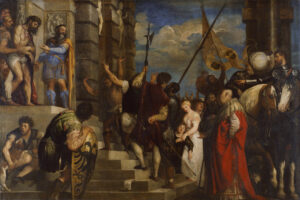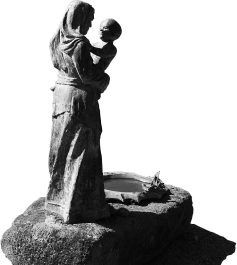Good Friday
When Pilate had Our Blessed Lord brought out to the people and pronounced the well-known words: Ecce Homo – Behold the Man, the Saviour had become unrecognisable. This may have been precisely what inspired the words in the first place. As Psalm 21 reminds us, Our Lord appeared more like a worm than a man, whence the need for Pilate to insist: this is a man. The Prophet Isaiah, for his part, foresaw the event centuries earlier and described his vision this way: Despised, and the most abject of men, a man of sorrows, and acquainted with infirmity: and his look was as it were hidden and despised, whereupon we esteemed him not. … We have thought him as it were a leper, and as one struck by God and afflicted (Is 53:3-4). A leper whose entire flesh is deformed by the awful disease, such that people cannot bear the sight: such is the image that Isaiah foresaw of the Messiah, the Christ, the Son of God in His passion. Behold the Man. Indeed, we know of the indescribable tortures of the Roman flogging that our Saviour endured; it was enough to have caused His death. There was not a single part of His sacred body that had not been lacerated, torn open by those terrible instruments of torture, to such an extent that, as Psalm 21 again says, one could see and even number the bones of the Saviour’s body. The Romans, conquerors of the world, ruthlessly beat down any opponents; the more suffering they could cause, the better. All had to be crushed under the mighty foot of Rome, even the Son of God.

This terrible vision should give us pause. Few artists have had the courage to depict it in all its horror, and probably for good reason. But in our contemplation of the mystery, it is good to follow the lead of the prophets who reveal so much to us of the event in their brief words. Any soul that has come to know and love our Blessed Saviour should be moved with the desire to dress those wounds, to pour soothing balm into those wide gaps left by the instruments of torture, just as any doctor or nurse, or any good, compassionate woman, would do everything in her power to ease the pain of that sacred body, and nurse it back to good health. If only it were given to us to do!
In a way, it is, for we know that the Church is the Mystical Body of Christ. She, too, undergoes her passion with Our Lord. She, too, follows Him in death before She can follow Him in glory. So when we lift up our eyes to that disfigured body of Our Saviour, and we hear Pilate saying Behold the Man, we should also think that he is prophetically showing us the Church. Few would disagree that the Church today appears like Our Lord in His passion, despised, abject in the eyes of men, as if struck by God, a spiritual leper of sorts that causes unspeakable grief to those who love Her as the Immaculate Bride of Christ. If our love for Jesus moves us to want to dress His wounds, we have at our fingertips one very definite way of doing so: it is to nurse the Church our Mother, to care for her wounds, to pour the soothing balm of compassion and prayer and good works, to make amends for all that afflicts her.
So many things harm her today, disfigure her, and make her appear to the world more a harlot than the immaculate Bride of Christ. And yet the bride she remains, even when so many of her children play the harlot, and so many of her shepherds seem more intent on pleasing the world and satisfying their own ambitions than feeding the flock of Christ and caring for their wounds. The sufferings and disfigurement of Our Saviour were entirely due to the sins of others, but the disfigurement of the Church is altogether the doings of her own children. While she remains immaculate, her children soil her with their abominations, but for the eyes of the world, it is the Church Herself that is to be scorned.
Here is the mystery: just as Our Lord was the eternal Son of God with the most perfect humanity and yet appeared to men prostrate under the tortures inflicted upon Him, so the Church, ever one with Her Spouse, appears before the world as one brought low and looked down upon by men. Many have only scorn for the Church, and that should not surprise us. Would it be right for the Bridegroom to be despised and not the Bride? The true bride wants to be like her spouse and share his sorrows.
What defiles the Church today? The list is long, and most of us could come up with a pretty comprehensive list in about five minutes. One symptomatic cause is that most Catholics today would not even be able to recite the Ten Commandments without the help of Mr Google. But let’s leave that for another day. For today, this day of the Church’s great mourning, let us turn the gaze of our hearts to Jesus, flogged and crowned with thorns and be reminded that every time we practice some self-denial and refuse some illicit pleasure or satisfaction, we are dressing one of those sacred wounds of the Saviour’s body. Every time we renounce a worldly ambition and step on our pride, we remove one of those sharp thorns from His sacred Head. Every time we stand up for what is good and true, or when we instruct the ignorant or counsel the doubtful or admonish the sinner, or give food to the hungry and drink to the thirsty, every time we visit someone who is sick or in prison, we bind up the wounds of the Church, we take an extra step in the direction of healing the Mystical Body of Christ, so that she may one day shine again with splendour before the world. The more of Christ’s faithful who make those little efforts each day, the more quickly will the Church recover the lustre she received from her Spouse, the day she was clothed in the garments of grace thanks to the sufferings of her Saviour.
The great lesson is this: As we are not afraid for Christ, so let us not be afraid for the Church. On the contrary, let us fear for ourselves that we truly remain in her unity, sheltered in her bosom. If we are truly there, we will suffer with her, and we will die with her, but then we will rise with her. But if we allow ourselves to be led astray by the sirens of the day, those deceitful voices that tell us stories of how happy we will be when we do whatever we please and invent our own religion and our own moral code, then we will not die, for we have lost hope – we are already dead.
In these dark hours that afflict Holy Mother Church, like the Mother of Sorrows at the foot of the Cross, let each of us seek to comfort her as any loving son or daughter seeks to comfort an afflicted mother. Let us seek to stop sinning and make amends for our own sins first, and then we will be in a better position to convert others and atone for their sins as well. Of course, none of this is possible on our own. Only the almighty grace of the Son of God made available for us in His sacred Passion, can obtain it for us, but it is there for the asking. On this day, the floodgates of mercy are opened upon all, as the great prayers we will recite shortly bear witness. For when the innocent willingly accepts to die for the guilty, the torrent of evil is turned back, and the most stupendous miracles become possible.


